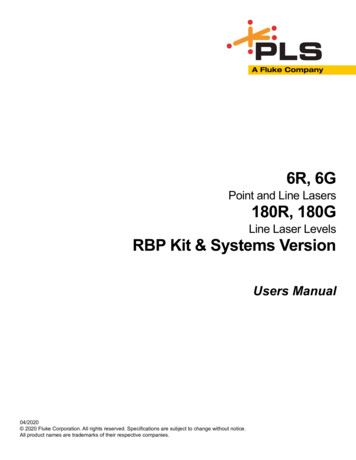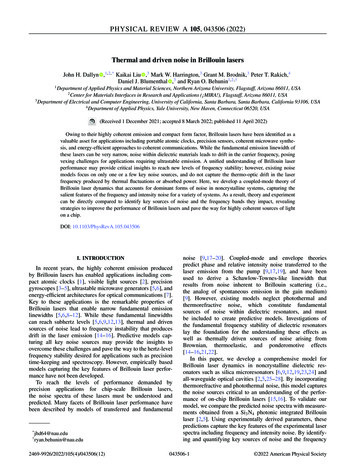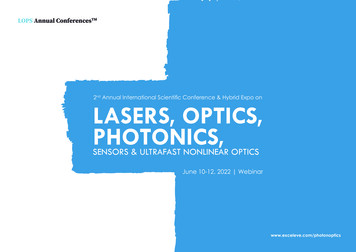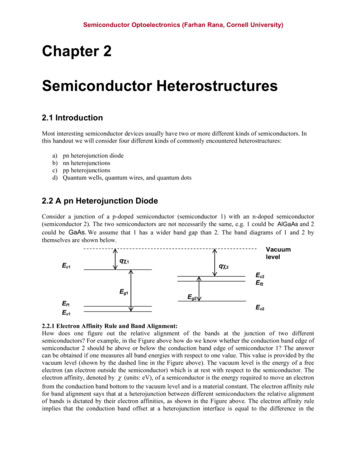Transcription
Optically PumpedSemiconductor LasersPower. Precision. Performance.– based on semiconductor lasersSuperior Reliability & Performance
History of
a BreakthroughFor more than a decade, solid-state lasers have been replacing legacy gas lasersin application after application. Even solid-state lasers, with their reputation forreliability and performance, have had limitations as it relates to accessible wavelengths and power ranges. In the late 1990’s Coherent identified the capabilitiesof a novel concept for a semiconductor based platform that would overcomethese limitations. Investing in fundamental developments and creating an IPposition, Coherent pioneered this concept and introduced the Optically PumpedSemiconductor Laser (OPSL). In 2001, the first commercial OPSL became availableas a technology breakthrough.Since their beginnings, OPSLs were considered the technology of choice in avariety of applications that require true CW output – from the UV to Visible andIR. OPSL technology enables us to improve many applications that were previouslylimited by the fixed wavelength and power of other laser technologies. Today, withOPSL technology, you no longer have to work around the closest fit wavelength.With OPSLs, you can find the best wavelength to fit your application.
OPSL Advantagesand BenefitsOptically Pumped Semiconductor LaserWavelength Scalability:Responding to the need for a broad range of wavelengths in many laser applications,OPSLs with their unique wavelength flexibility, are different from any other solid-statebased laser. The fundamental near-IR output wavelength is determined by the structureof the InGaAs (semiconductor) gain chip, and can be set anywhere between 920 nm and1154 nm, yielding frequency-doubled and tripled output between 355 nm and 577 nm.This enables a paradigm shift in the way laser applications are supported by lightsources. Before OPSL technology, photonic engineers would have to choose fromavailable laser sources for a wavelength that most closely met the needs of the application. In an OPSL however, the laser wavelength and other operating parameters can betailored to match the application, instead of vice versa.Power Scalability:Applications vary greatly in their power requirements. From low power applicationsin life sciences to high power applications in research or medical, and even within aspecific application, OPSL serves these diverse needs due to its inherent power scalability.Increasing the spot size on the OPSL chip as well as the power from the IR pump diodeprovides unprecedented multi-watt scalability. The path towards even higher powersopens up by using cavity designs with multiple OPSL chips inside the cavity. Powers up to70W have been demonstrated.Increasing the output power in any solid-state laser based on a diode-pumped, rodshaped gain medium produces a thermal lens effect that must be exactly balancedby other cavity optics. Because the OPSL gain medium is a thin semiconductor waferefficiently cooled from its rear sub-mount, it is possible to operate the chip reliably atmulti-watt output levels by increasing the pump interaction volume on the chip. Itproduces virtually no radial thermal gradient,i.e. no thermal lensing. The absence of thermallensing makes an OPSL capable of operationOPS2over a wide range of output powers from agiven cavity design – all while maintaining otherOPS1critical operating parameters, such as noiseBRFand mode quality. This makes an OPSL-basedTHGsolution a versatile and flexible laser engine.SHGExample of a Multichip Cavity Design
Inherent Reliability:Efficient and simple, pumping of the semiconductor gain medium is another advantage over other diodepumped laser types. Specifically, the pump wavelength merely needs to be shorter than the band gap of thesemiconductor laser in OPSL, whereas a DPSS laser needs to have the pump laser matched to the specific gainmedium. In an OPSL there is no need to select pump diodes based on their precise wavelength characteristics,and there is little need for a feedback temperature control loop to hold the pump wavelength constant duringlaser operation. Both provide benefits in overall cost, complexity and reliability.OPSLs have proven to be extremely reliable. With over 20,000 units in the field, lifetime statistical data showsthat the OPSL is the most reliable and flexible laser technology ever produced by Coherent. The higher reliabilitytranslates into a marked reduction in cost of ownership compared to other CW laser technologies, includingIon and diode-pumped solid-state lasers.Harmonic Generation:Harmonic generation, including Second Harmonic Generation and Third Harmonic Generation, is key formany laser applications that require shorter wavelengths in the UV and visible than the gain medium’sfundamental wavelength. It is a nonlinear process and depends on the square of the power. Accordingly,for continuous wave operating lasers, harmonic crystals are placed inside the cavity to take advantage of thehigh intracavity power. The OPSL concept has two design advantages compared to conventional diode-pumpedsolid-state lasers based on crystal gain mediums such as Nd:YAG or Nd:Vanadate. The first relates to thesemiconductor gain medium. This is because the upper state lifetime in the semiconductor chip is so shortthat an OPSL does not store gain and is free of the mode interference problem or so called “green noise”,occurring in cavities with harmonics that operate on multiple longitudinal modes.In some commercial lasers, manufacturers have purposefully used a longer (potentially less stable) cavityhaving a high density of longitudinal modes in an attempt to reduce the overall green noise. Before OPSLs,the lowest noise performance was enabled by designing Nd:YAG or Nd:Vanadate cavities for single modeoperation. The OPSL design does not require any of this to deliver ultra-low noise performance fromharmonic generation.With no stored gain, dynamic fluctuations found in DPSS lasers are completely absent in an OPSL and thelongitudinal mode-pattern is thus entirely determined by the characteristics of the laser cavity. With thiscompletely static mode pattern, there are no fluctuations in the overall doubling efficiency, and thereforeno “green noise.” As a result, the latest multi-watt OPSL (Coherent Verdi G) delivers rms noise performanceof 0.03 % over a bandwidth of 10Hz to 100 MHz, making it ideal for ultra-low noise applications inTi:Sapphire pumping.The second advantage of the OPSL concept relates tothe intra-cavity second harmonic generation (SHG)that is not only a low-noise process, but also a very efficient one. This is because SHG scales with the squareof the circulating power in the near-IR fundamental,which is markedly higher in an OPSL than in a diodepumped solid-state laser with the same diode pumpintensity. The InGaAs is a relatively low gain material sothe cavity supports a high saturation power level andthe circulating power vs. diode current stays linear tohigher power levels.OPSL technology does not produce“green noise”, because of the extremely shortexcited-state lifetime of the gain medium.
Markets andApplicationsLife Sciences:Most applications in life sciences are based on exciting fluorescentdyes. The different absorption peaks of the growing number of dyesdrives a continuous demand for new wavelengths. OPSL’s inherentwavelength scalability provides a versatile laser source for life sciences.Higher throughput requirements achieved by higher power density onthe sample or process parallelization are supported by the wavelengthscalability or ‘targeting’ of OPSLs. The excellent spatial TEM00 modequality and superior noise performance makes OPSL the choice for theprecision and sensitivity required for advanced life sciences applicationssuch as flow cytometry, confocal microscopy, diagnostic imaging or genomics. This market is served by two members of our OPSL family – theSapphire lasers and the Genesis lasers with single spatial mode quality.Medical Therapeutics:Lasers in medical applications prefer spatial multimode performance.OPSLs have been designed for optimum performance in multimode orsingle mode operation. Combined with power and wavelength scaling capabilities, this provides the preferred solution for therapeuticsapplications such as ophthalmology or dermatology/aesthetics.An example of this is the 3 Watt 577 nm laser designed for laser-basedphotocoagulation treatment of wet-form age-related macular degeneration (AMD). This 577 nm wavelength was chosen to coincide withthe strong absorption peak of oxy-hemoglobin, enabling superiorphotocoagulation results with better tissue discrimination and betterpatient comfort. At the same time the direct modulation capability ofOPSLs proved to be advantageous in medical applications.The innovations associated with the Genesis 577 family were recognizedby Laser Focus World with a 2008 PHAsT award and by SPIE/PhotonicsSpectra with the 2009 PRISM tie award. The design elegance of OPSLprovides compact and cost efficient solutions for multimode performance in medical therapeutics.As a versatile solution in medical therapeutics, OPSLs have the promiseto advance other areas such as dermatology and aesthetics replacinglegacy laser technology.
Lightshow and Display:Lightshow and display applications have historically been served bywater-cooled Ion lasers because of their availability in high power andmultiple wavelengths. Alternatively Nd:YAG and Nd:Vanadate basedsolid-state laser technology offered a limited selection of green andblue wavelengths but no red or yellow. OPSL is the technology thatmeets all requirements of lightshow and display. The wavelengthscalability provides a breakthrough with more vibrant colors. Highbrightness and high power beam quality at all three fundamentalcolors (RGB) enables benchmark quality for lightshows. Direct modulation of the OPSL eliminates costs and complexity required with legacyIon or other solid-state laser sources. The modular, compact and costefficient concept of the Genesis Taipan family gives integrators thechoice of options to optimize their lightshow tools for end users.Providing the different colors from the same platform facilitates easydesign and integration.Defense and Forensics:The rugged design of an all semiconductor laser makes OPSL solutionsa compelling choice for demanding applications in defense and militarysuch as dazzlers and target illumination. The power scalability androbustness of OPSLs open the path for other applications into the tensof Watts or even higher power range. Multi OPSL chip cavity designsdifferentiate OPSL based solutions with compactness and ruggednessin high power performance.In Forensics, OPSL is the engine in our TracER system, a forensic laser toolused for evidence recovery. Different colors available from OPSL enginespower a range of TracER products that expand the forensics applicationsto detect fingerprints, liquids or other samples. The high electrical tooptical conversion efficiency of OPSL enables field deployable andcompact battery powered solutions. These systems are in use withinthe FBI, local police departments, CSI and other international agencies.Research:The Verdi family, long recognized as the leading source in Ti:Sapphire laserpumping, is benefiting from OPSL technology. The Verdi G Series offersmulti-watt performance today. The zero upper state lifetime of an OPSLgain chip enables the lowest amplitude noise, instrumental to state-ofthe-art ultrafast applications. The new Verdi G series equals or exceedsthe leading ultra low noise standard of Verdi Vanadate-based solutionsbut without the need to design the laser for single longitudinal modeperformance. OPSL by design is free of the green noise problem inherent in multi longitudinal mode based solid-state solutions. Fast warmup, easy setup with diodes integrated in the laser head, state-of-the-artpower supply, and control features make the Verdi G the next generation of Ti:Sapphire pump lasers.
OPSL TechnologyBackgroundThe proven OPSL format is optimal for several reasons. Similar toVCSELs and unlike edge emitting laser diodes, the OPSL chip emitslight perpendicular to the diode junction. This vertical emissionis one of the keys to the excellent spatial mode performanceof an OPSL. It also gives OPSLs the unique capability to scaleto higher powers not available from conventional electrically pumped VCSELs. In an OPSL the large chip area needed forhigher powers can easily be pumped optically, while in the caseof electrically pumped VCSELs the extended electrodes wouldintroduce extended losses. Furthermore OPSL technology allowsthe use of external optics to design advanced laser cavities andtailor output beam characteristics based on the application.Access to the intra-cavity beam makes OPSL the ideal design touse nonlinear crystals to produce wavelengths in the UV andvisible spectrum.The key element of an OPSL is the OPS chip which serves as again medium and a cavity mirror simultaneously. This monolithic III-V semiconductor chip contains GaAS layers to absorb theIR light of a semiconductor pump diode alternated withInGaAs quantum wells. Charge carriers generated in the pumpabsorption layers fuel recombination in the quantum well layerand drive the IR lasing process. The stoichiometry and physicaldimensions of the quantum wells determine the wavelength,just like with a conventional semiconductor laser diode.Behind these absorption/emission layers, the OPS chip alsoincorporates several alternating high index and low index layersthat act as a low-loss Distributed Bragg Reflector (DBR) optimizedfor maximum reflectivity at the specific OPSL output wavelength,and which forms one of the cavity mirrors.Near-infrared pump light provided by a diode array or singleemitter is focused on the front surface as indicated in Figure 1.This schematic illustration shows thebasic principles of OPSL technology.Figure 1
OPSL SolutionPortfolioWith more than 20,000 OPSLs installed in a wide range of applications, the OPSL platform todayencompasses a broad range of solutions. Sapphire was the world’s first commercial solid-state488 nm laser at the beginning of the breakthrough with OPSL technology. Today, low noise singlespatial mode performance is available from Sapphire at power levels up to 500 mW and variouswavelengths in the visible spectrum. Sapphire now offers other wavelengths including extensionsinto the yellow wavelength spectrum. The Genesis family today extends the portfolio in the visibleup to 8W for research. In the UV at 355 nm, Genesis was the first true CW solid-state laser for lifescience and other applications that benefit from low noise performance and is free of thepotential biological damage from peak power present with conventional modelocked quasi CWlasers. For medical, lightshow and display applications, the Genesis family includes a broad rangeof single to multi-mode lasers for OEM integration.OPSL is also the engine in one of the most versatileforensic laser systems, the TracER.With OPSLs being the ideal source for nonlinear wavelength conversion, there is a wide range of conceptsunder investigation that will broaden the spectrumavailable.
Today’sOPSL ProductsGenesis-TracER 3W to 8W at 532 – Forensic ScienceGenesis-3W at 532 – Advancing OphthalmologyGenesis-Taipan 3W at 532 – Lightshow
Coherent has pioneered OPSL technology,bringing to market a wide range of highlyreliable lasers engineered to our customer’stechnical and commercial needs.6W to 8W Laser based on OPSL addedto the Verdi G-Series – Ti:S pumping
Tomorrow’sOPSL ProductsLasers have come a long way over the last nearly 50 years. Ion laser technology has succumbed to CW diode-pumped solid-state (DPSS) technology,and more recently Optically Pumped Semiconductor Lasers have replacedDPSS lasers. This new generation of lasers provide higher reliability andlower cost per watt than all earlier technologies. The OPSL design inherentbenefit of wavelength scalability will continue to broaden the applicationsfor OPSL. Access to new wavelengths will be instrumental to grow applicationsin the life sciences segment where new fluorescent dyes and other sampletargets are asking for new excitation wavelengths. In the medical therapeuticsarea new wavelengths will be a key element for emerging procedures inophthalmology or dermatology. With unique power scalability, the marketfor OPSL based solutions will continue to expand. With demonstrated powerlevels of up to 70W, OPSL will enter new markets such as materials processing,and expand further into others such as defense due to its design simplicityand ruggedness. The combination with other nonlinear wavelength extensions such as parametric oscillators will bring OPSL benefits to applicationsin the mid IR range. In the scientific and research area, the launch of the VerdiG as the new generation of more effective Ti:Sapphire pumping lasers is thestart for an expansion in new scientific applications. This might includefurther non linear harmonic accessories such as OPOs, or higher power andnew wavelengths for pumping applications.OPSL is the next generation of CW solid-state lasers for a wide field ofexisting and new applications. Please contact us to discuss what benefitsOPSL can bring to your application.
Coherent as Your Partner.To compete and succeed in today’s fast-paced research and manufacturing environments, you needa laser partner who understands your needs. A partner who can provide a wide range of technologysolutions, and the support that goes with them.Since 1966, Coherent has been helping customers by providing complete laser-based solutions fora wide range of commercial and scientific applications.With a heritage of innovation and an uncompromising position on quality, Coherent is the mostforward-thinking and diversified manufacturer of solid-state, gas, excimer and semiconductor lasersin the industry.For more information, visit us on the Web at www.Coherent.com. Or call 800-527-3786.Coherent, Inc.5100 Patrick Henry DriveSanta Clara, CA 95054phone (800) 527-3786(408) 764-4983fax (408) 764-4646e-mail alyJapanKoreaUKwww.Coherent.comPrinted in the U.S.A. MC-xxx-10-0M0110Copyright 2010 Coherent, Inc.Superior Reliability & Performance 31 (30) 280 6060 86 (10) 6280 0209 33 (0)1 6985 5145 49 (6071) 968 333 39 (02) 34 530 214 81 (3) 5635 8700 82 (2) 460 7900 44 (1353) 658 833
for continuous wave operating lasers, harmonic crystals are placed inside the cavity to take advantage of the high intracavity power. The OPSL concept has two design advantages compared to conventional diode-pumped solid-state lasers based on crystal gain mediums such as Nd:YAG or Nd:Vanadate. The first relates to the semiconductor gain medium.







